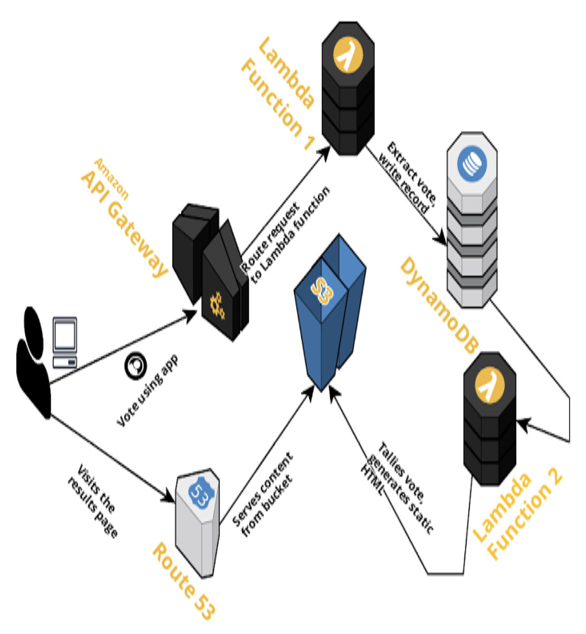Remember to replace placeholders such as YourTableName and attribute values with actual values specific to your use case. These commands allow you to manage DynamoDB resources programmatically using the AWS CLI, enabling automation and integration with your application deployment processes.
The following diagram depicts the basic setup of DynamoDB in the AWS cloud:

Figure 8.1: DynamoDB and Lambda functions in the AWS cloud
Now let’s understand the major differences between some popular NoSQL databases such as MongoDB, Redis, and DynamoDB. We will focus on elucidating the significant distinctions among popular NoSQL databases, specifically MongoDB, Redis, and DynamoDB. Readers can anticipate an insightful comparison covering various aspects such as data models, query languages, scalability, and use cases. This exploration aims to provide a nuanced understanding, helping readers make informed decisions when choosing a NoSQL database based on their specific requirements and preferences:
- MongoDB:
• Data model: MongoDB is a document-oriented NoSQL database that stores data in flexible, JSON-like BSON documents. Each document can have a different structure.
• Use cases: MongoDB is suitable for a wide range of use cases, including content management systems (CMSs), e-commerce platforms, catalog management, and real-time analytics.
• Example: Storing product information in an e-commerce application where each product has various attributes such as name, price, description, and images. - Redis:
• Data model: Redis is an in-memory key-value store that supports various data structures such as strings, lists, sets, hashes, and more.
• Use cases: Redis is ideal for caching, real-time analytics, session management, message queues, and leaderboards.
• Example: Caching frequently accessed database queries or storing user sessions in a web application. - DynamoDB:
• Data model: DynamoDB is a managed NoSQL database provided by AWS. It uses a schema-less model with tables and items. Each item can have a different set of attributes.
• Use cases: DynamoDB is suitable for applications requiring high-speed, low-latency data access, such as gaming leaderboards, real-time applications, and IoT data storage.
• Example: Storing user preferences in a mobile app where each user has different attributes such as favorite genres, watch history, and ratings.
Major differences:
• Data structure:
• MongoDB uses flexible, schema-less documents.
• Redis employs a key-value structure with various data types.
• DynamoDB uses tables and items with flexible attributes.
• Data persistence:
• MongoDB provides both in-memory and on-disk storage options.
• Redis is an in-memory database but supports disk persistence.
• DynamoDB is a managed service with data automatically persisted.
• Scalability:
• MongoDB supports horizontal scaling through sharding.
• Redis and DynamoDB offer automatic horizontal scaling.
• Query language:
• MongoDB offers a powerful query language.
• Redis provides simple key-based queries.
• DynamoDB uses Query and Scan operations for data retrieval.
• Consistency and availability:
• MongoDB offers tunable consistency levels.
• Redis supports eventual consistency.
• DynamoDB provides strong consistency by default but allows eventual consistency for read operations.
• Complex transactions:
• MongoDB and DynamoDB offer multi-document transactions.
• Redis supports transactions on multiple commands, but not ACID transactions.
Benefits of NoSQL databases:
• Flexible data models: NoSQL databases accommodate various data structures, including key-value, document, column-family, and graph models. This flexibility allows developers to store diverse data types within the same database.
• Scalability: NoSQL databases are designed to scale horizontally, distributing data across multiple servers or nodes. This makes them well suited for handling large volumes of data and high traffic loads.
• High performance: Many NoSQL databases, such as in-memory stores, offer fast data retrieval and processing. This is particularly beneficial for applications that require real-time analytics or rapid responses.
• Schema evolution: NoSQL databases don’t enforce rigid schemas, allowing data structures to evolve over time. This flexibility is advantageous when dealing with changing or unpredictable data requirements.
• Distributed architecture: NoSQL databases often employ distributed architectures that provide HA and FT. Data is replicated across nodes to ensure data durability and availability.
• Horizontal partitioning: NoSQL databases enable data to be partitioned and distributed across nodes, reducing the need for complex join operations and enhancing performance.
• Support for large data volumes: NoSQL databases are designed to handle large amounts of data efficiently, making them suitable for applications dealing with big data.
• Use cases: NoSQL databases are well suited for various use cases, including real-time analytics, CMSs, social media applications, IoT data storage, and more.
• Simplified development: The schema-less nature of NoSQL databases simplifies the development process, allowing developers to focus on building applications rather than managing complex schema designs.
• Cloud compatibility: NoSQL databases align well with cloud-native architectures and provide options for easy deployment and scaling in cloud environments.